A drone manual PDF is an essential guide for understanding your drone’s features, ensuring safe operation, and optimizing performance. It covers pre-flight checks, assembly, and troubleshooting, making it a vital resource for both beginners and experienced users to maximize their flying experience.
1.1 Importance of a Drone Manual
A drone manual is crucial for safe and effective operation, providing detailed guidance on features, safety protocols, and troubleshooting. It ensures compliance with legal requirements and helps users understand their drone’s capabilities, maximizing performance and longevity. The manual acts as a comprehensive reference, addressing pre-flight checks, assembly, and maintenance, making it indispensable for both beginners and experienced pilots to ensure optimal and responsible drone usage;
1.2 What to Expect in a Typical Drone Manual
A typical drone manual includes detailed sections on pre-flight checks, assembly instructions, and remote control functions. It covers safety guidelines, legal considerations, and troubleshooting tips. Users can expect step-by-step guides for calibrating the drone, understanding camera settings, and maintaining the device. The manual also provides information on battery care, propeller installation, and software updates. Additionally, it often features diagrams and images to aid in understanding complex components. This comprehensive resource ensures users can operate their drone safely and effectively, addressing both basic and advanced functionalities.

Key Considerations When Choosing a Drone
When selecting a drone, consider camera quality, flight time, ease of use, and cost. These factors ensure you find a drone that meets your needs and budget effectively.
2.1 Camera Quality and Features
Camera quality is crucial for capturing stunning aerial photos and videos. Look for drones with high-resolution sensors, 4K capability, and image stabilization for crisp footage. Features like FPV (First-Person View) and optical flow positioning enhance photography and videography. Some drones offer advanced modes for professional-grade results. Consider models with adjustable cameras and gimbals for stability. The manual provides detailed guidance on camera settings and features, ensuring you maximize your drone’s imaging capabilities for both casual and professional use.
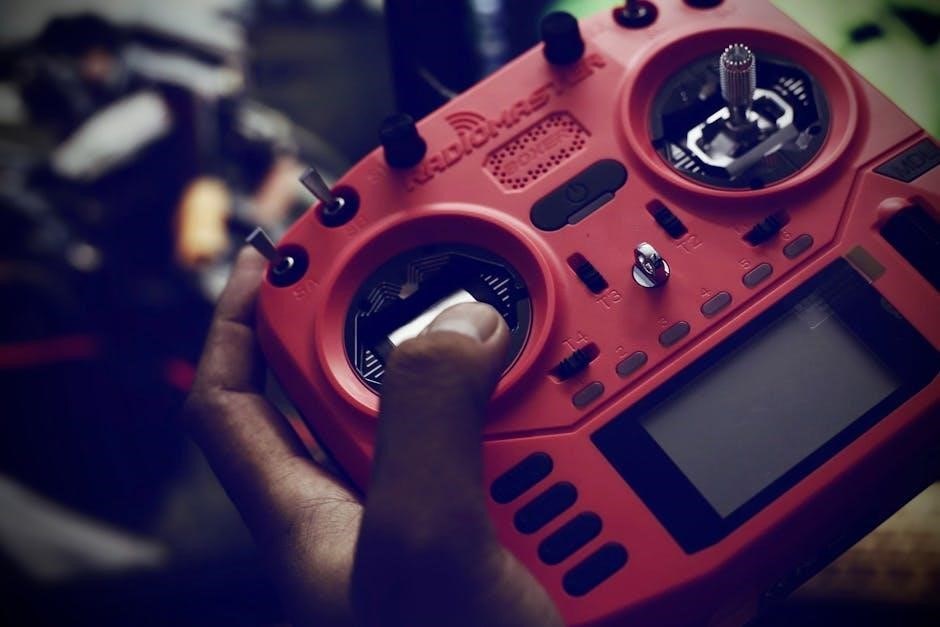
2.2 Flight Time and Battery Life
Flight time and battery life are critical factors for an optimal drone experience. Most drones offer 20-30 minutes of flight time, depending on weight, features, and usage. Battery capacity and charging time are detailed in the manual, ensuring safe and efficient use. Proper maintenance, like avoiding overcharging, extends battery longevity. The manual provides guidelines for monitoring battery health and optimizing flight duration, helping users make the most of their drone’s performance and ensuring reliable operation during aerial photography and exploration.
2.3 Ease of Use for Beginners

Ease of use is crucial for beginners, and a good drone manual ensures a smooth start. Many drones feature one-key takeoff, voice gesture control, and optical flow positioning, simplifying operation. The manual guides users through these features, making it easier to learn and master. Step-by-step instructions and troubleshooting tips help beginners overcome initial challenges. With clear guidance, new users can quickly understand controls, ensuring a safe and enjoyable flying experience from the start.
2.4 Cost and Value for Money
When choosing a drone, cost and value are key considerations. Drones vary widely in price, from budget-friendly options for beginners to advanced models with high-end features. The manual often highlights the drone’s features relative to its price, helping users assess value. For instance, a drone with 4K camera capabilities and obstacle avoidance may justify a higher cost. Manuals also guide users on maintaining their drones, ensuring longevity and maximizing the return on investment. This balance of cost and functionality is essential for making an informed purchase decision.
Understanding the Drone Manual
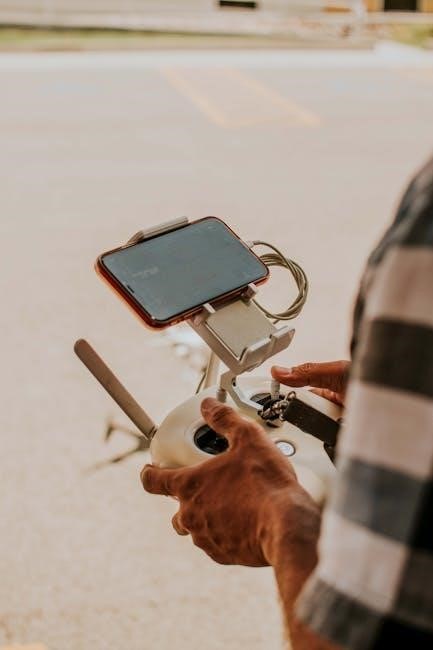
A drone manual is a comprehensive guide detailing the drone’s features, operation, and maintenance. It ensures safe and effective use, covering everything from assembly to troubleshooting, making it an essential resource for all users.
3.1 Pre-Flight Checks and Safety Guidelines
Before flying, ensure the drone’s battery is fully charged and free from damage. Inspect propellers for wear or damage and calibrate the GPS and compass; Check the surroundings for obstacles and ensure the drone is in an open, safe area. Verify local regulations and weather conditions. Always perform a system check using the DJI Fly app or similar software. Follow safety guidelines to avoid accidents and ensure a smooth flight experience. Refer to the manual for specific pre-flight procedures tailored to your drone model.
3.2 Step-by-Step Assembly Instructions
Begin by unpacking and organizing all drone components. Attach the propeller blades securely, ensuring they are properly aligned and tightened. Next, install the camera and gimbal, following the manual’s specific mounting instructions. Connect the remote controller and sync it with the drone. Use the provided tools to secure any loose parts. Refer to the diagram in the manual for correct assembly. Double-check all connections and ensure the battery is correctly installed. Follow the step-by-step guide to avoid damage and ensure a safe, functional setup.
3.3 Remote Control and Function Key Instructions
Understand the remote control layout and function keys to master drone operation. The remote typically includes joysticks for directional control, a power button, and function keys for specific commands. Sync the remote with the drone by following the manual’s pairing instructions. Familiarize yourself with keys for takeoff, landing, and mode switching. Some remotes feature customizable buttons for advanced functions. Practice using the remote in an open area to ensure smooth control. Refer to the manual for detailed instructions on optimizing remote functionality and troubleshooting connectivity issues for seamless flight experiences.
Drone Components and Accessories
A typical drone includes essential components like propeller blades, motors, and a battery. Accessories such as gimbals, cameras, and carrying cases enhance functionality and user experience.
4.1 Propeller Blades and Motors
Propeller blades and motors are critical components of a drone, ensuring stable and efficient flight. The manual provides detailed instructions on installing and maintaining these parts. High-quality motors offer durability and smooth operation, while balanced propeller blades enhance stability. Regular inspection and proper storage are essential to prevent damage. The guide also covers troubleshooting common issues, such as uneven wear or motor overheating, to ensure optimal performance and longevity of these vital components.
4.2 Battery and Charging Instructions
The drone manual PDF provides detailed guidance on battery installation, charging procedures, and safety precautions. It emphasizes the importance of using the correct charger and avoiding overcharging to prevent damage. The manual also outlines steps to maximize battery lifespan, such as storing the battery at a 50% charge when not in use. Proper charging practices ensure optimal performance and extend the drone’s operational efficiency, making it a crucial section for all users to review carefully before first use.
4.3 Camera and Gimbal Setup
The drone manual PDF includes a detailed section on camera and gimbal setup, ensuring high-quality aerial photography and videography. It guides users through mounting the camera, balancing the gimbal, and calibrating settings for stability. The manual also explains how to adjust camera angles and focus for optimal results. Additionally, it covers features like image stabilization and zoom functionality, helping users capture professional-grade footage. By following these instructions, users can unlock their drone’s full creative potential and achieve stunning visual outcomes during flights.
Installation and Setup
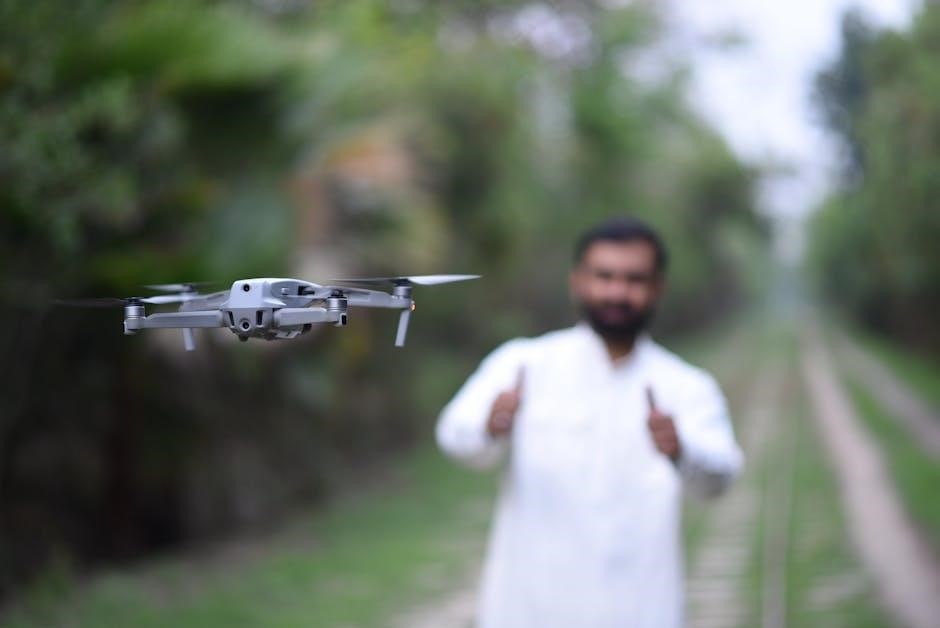
The drone manual PDF guides users through installation and setup, including downloading the app, connecting the drone to the remote, and calibrating for first use.
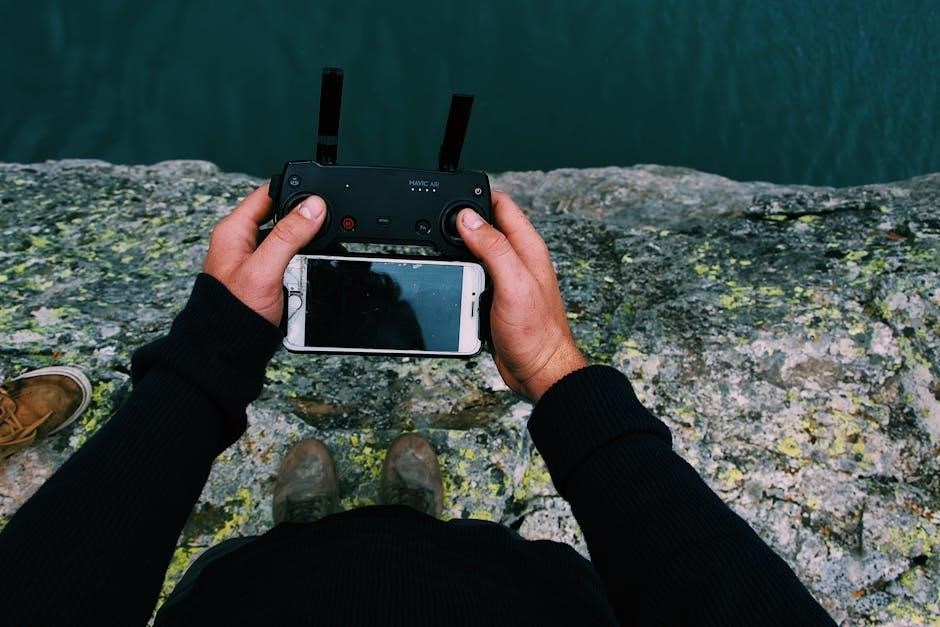
5.1 Downloading and Installing the Drone App
Downloading and installing the drone app is a crucial step in setting up your device. Most manuals guide users to scan a QR code or visit an official website to download the app. Ensure your smartphone meets the app’s compatibility requirements. Once installed, register or log in to your account. The app typically allows firmware updates, flight mode adjustments, and camera settings customization. Follow the in-app instructions for pairing the drone and remote controller. This step ensures seamless communication between devices, enabling a smooth flying experience.
5.2 Connecting the Drone to the Remote Controller
To connect the drone to the remote controller, power on both devices. The remote controller will typically enter pairing mode automatically, indicated by flashing LED lights. Ensure the drone is in pairing mode as well, usually by pressing and holding a specific button; Follow the manual’s instructions for syncing, which may involve a series of button presses or using the drone app. Once connected, the remote’s sticks will control the drone’s movements. Always test the connection before flight to ensure responsiveness and safety.
5.3 Calibrating the Drone for First Use
Calibrating your drone ensures accurate flight performance and stability. Start by placing the drone on a flat, level surface. Open the drone app and navigate to the calibration section. Follow the on-screen instructions to complete the process, which may include rotating the drone 360 degrees and aligning the compass. Ensure the remote controller is paired and functional. Once calibration is complete, test the drone in an open area to verify smooth operation. Proper calibration is crucial for safe and precise flying experiences.

Flying Techniques and Tips
Mastering drone flight involves starting in open spaces, utilizing flight modes, and practicing smooth control movements. Use GPS for stability and avoid obstacles for safe, precise maneuvers.
6.1 Basic Flight Maneuvers for Beginners
Beginners should start with simple maneuvers like hovering, throttle control, and basic directional movements. Use one-key takeoff/land for ease and practice in open spaces. Mastering altitude control and smooth transitions ensures stability. Familiarize yourself with the remote controller’s joysticks for precise movements. Start with short flights to build confidence and gradually incorporate features like optical flow positioning or waypoint flying for smoother navigation. Avoid obstacles and practice turning, ascending, and descending slowly. These foundational skills will enhance your flying experience and prepare you for more advanced techniques.
6.2 Advanced Flying Modes and Features
Advanced flying modes like waypoint navigation, follow-me, and gesture control enhance your drone experience. Waypoint flying allows you to set a custom path for the drone, ideal for mapping or surveillance. Follow-me mode keeps the drone tracking you, perfect for dynamic photography. Gesture control enables hands-free commands, adding convenience. Additionally, features like 360-degree flips and obstacle avoidance ensure smooth, professional-level maneuvers. These modes require precise setup and practice to master, but they unlock creative possibilities and improve flight efficiency. Always refer to your manual for specific activation and safety guidelines.
Maintenance and Troubleshooting
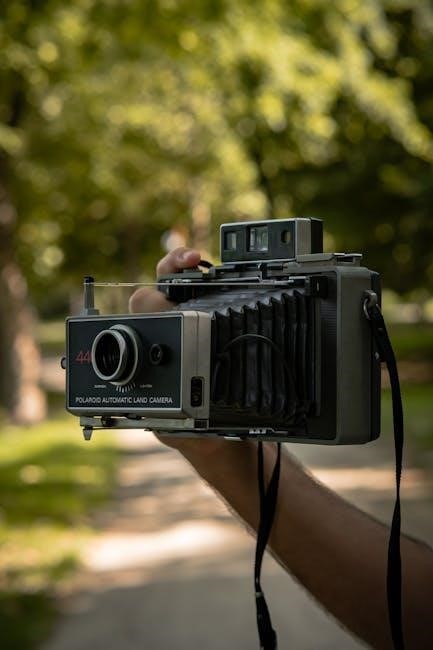
Regular maintenance ensures optimal drone performance and longevity. Clean propellers, motors, and sensors, and update software. Troubleshoot common issues like battery drain or connectivity problems by referring to the manual.
7.1 Regular Maintenance Tips
Regular maintenance is crucial for extending your drone’s lifespan and ensuring smooth operation. Clean the propellers and motors after each use to remove dirt and debris. Inspect the propeller blades for damage and replace them if necessary. Check the battery health, ensuring it’s stored properly when not in use. Update the drone’s firmware and software regularly to access new features and improvements. Lubricate moving parts and ensure all connections are secure. Refer to the manual for specific maintenance schedules and guidelines tailored to your drone model.
7;2 Common Issues and Solutions
Common drone issues include poor battery life, connectivity problems, and damaged propellers. For battery issues, ensure proper charging and storage. Connectivity problems can often be resolved by resetting the drone and remote controller. Damaged propellers should be replaced immediately to avoid further damage. Refer to the manual for troubleshooting guides specific to your model. Regular software updates and calibration can prevent many issues. If problems persist, consult the manual or contact customer support for assistance. Always follow the manufacturer’s guidelines for repairs and maintenance to ensure safety and optimal performance.

Legal and Safety Considerations
Adhering to local drone laws, respecting privacy, and following safety guidelines are crucial. Ensure compliance with no-fly zones, altitude limits, and insurance requirements. Always practice responsible flying.
8.1 Drone Laws and Regulations
Understanding drone laws and regulations is crucial for legal and safe operation. Many countries require registration for drones over a certain weight, and pilots must adhere to no-fly zones near airports, national parks, and stadiums. Altitude restrictions, typically below 400 feet, are common to ensure aviation safety. Additionally, some regions mandate pilot certification or insurance. Always check local regulations before flying, as violations can result in fines or penalties. Staying informed ensures compliance and responsible drone usage.
8.2 Best Practices for Safe Flying
Safe flying practices are essential to ensure a enjoyable and risk-free experience. Always conduct pre-flight checks, including battery health and propeller condition. Avoid flying near obstacles like trees, power lines, or buildings. Maintain a clear line of sight with your drone and never fly in poor weather conditions. Keep the drone within weight limits and follow all manufacturer guidelines. Use GPS features to avoid collisions and respect privacy by not flying over private property without permission. These practices help prevent accidents and ensure responsible drone operation.
A well-structured drone manual PDF ensures safe, efficient, and enjoyable drone operation. By following guidelines and exploring features, users can maximize their drone experience and capture stunning moments effortlessly.
9.1 Final Tips for Maximizing Drone Usage
Regularly maintain your drone to ensure optimal performance and longevity. Explore advanced features like GPS and waypoint navigation for precise flights. Use the drone app for real-time monitoring and adjustments. Practice in open spaces to master complex maneuvers. Stay updated with the latest software and firmware updates. Always follow legal guidelines and safety protocols. By combining these strategies, you can unlock your drone’s full potential and capture stunning aerial footage with ease and confidence.
9.2 Importance of Referencing the Manual
The drone manual PDF serves as a comprehensive guide, ensuring safe and effective operation. It provides detailed instructions for setup, maintenance, and troubleshooting, helping users avoid common mistakes. Referencing the manual guarantees compliance with legal and safety standards, optimizing performance, and extending the drone’s lifespan. It also helps users understand advanced features and new technologies, making it an indispensable resource for both beginners and experienced pilots to get the most out of their drone.
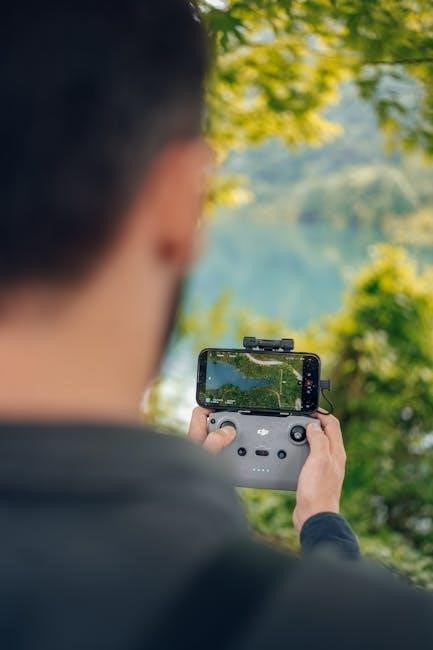
Leave a Reply
You must be logged in to post a comment.